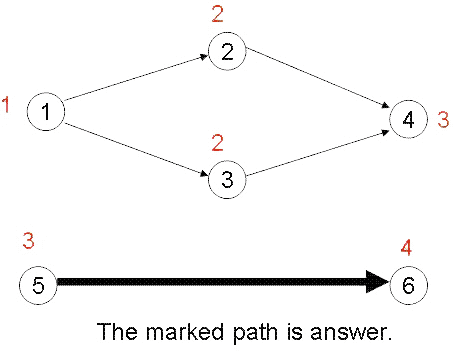Test for Job Time Limit: 5000MS Memory Limit: 65536K Total Submissions: 8990 Accepted: 2004
Description
Mr.Dog was fired by his company. In order to support his family, he must find a new job as soon as possible. Nowadays, It's hard to have a job, since there are swelling numbers of the unemployed. So some companies often use hard tests for their recruitment.
The test is like this: starting from a source-city, you may pass through some directed roads to reach another city. Each time you reach a city, you can earn some profit or pay some fee, Let this process continue until you reach a target-city. The boss will compute the expense you spent for your trip and the profit you have just obtained. Finally, he will decide whether you can be hired.
In order to get the job, Mr.Dog managed to obtain the knowledge of the net profit Vi of all cities he may reach (a negative Vi indicates that money is spent rather than gained) and the connection between cities. A city with no roads leading to it is a source-city and a city with no roads leading to other cities is a target-city. The mission of Mr.Dog is to start from a source-city and choose a route leading to a target-city through which he can get the maximum profit.
Input
The input file includes several test cases.Output
The output file contains one line for each test cases, in which contains an integer indicating the maximum profit Dog is able to obtain (or the minimum expenditure to spend)Sample Input
6 5 1 2 2 3 3 4 1 2 1 3 2 4 3 4 5 6
Sample Output
7
Hint

Source
POJ Monthly--2007.07.08, 落葉飛雪
題意:
給你一個圖,求一條起點(入度為0)到終點(出度為0)的路,滿足所有點的val之和最大。
思路:
開始想的是SPFA,然後無盡的TLE,後來用記憶化搜索過了。
有一個簡單的小處理就是增加一個源點對所有的起點建邊。
代碼:
#include#include #include #include #define maxn 100005 #define MAXN 2000005 #define INF 0x3f3f3f3f typedef long long ll; using namespace std; ll n,m,ans,cnt,sx,oo; bool vis[maxn]; ll dp[maxn],head[maxn]; ll in[maxn],val[maxn]; struct Node { ll v,w,next; }edge[MAXN]; void addedge(ll u,ll v,ll w) { cnt++; edge[cnt].v=v; edge[cnt].w=w; edge[cnt].next=head[u]; head[u]=cnt; } ll dfs(ll u) { if(dp[u]!=oo) return dp[u]; ll i,j,t,v,best=oo,flg=0; for(i=head[u];i;i=edge[i].next) { flg=1; v=edge[i].v; dfs(v); best=max(best,dp[v]); } if(flg) dp[u]=best+val[u]; else dp[u]=val[u]; } int main() { ll i,j,u,v,w; oo=-(1LL<<50); while(~scanf("%lld%lld",&n,&m)) { for(i=1;i<=n;i++) { scanf("%lld",&val[i]); } cnt=0; for(i=0;i<=n;i++) head[i]=in[i]=0; for(i=1;i<=m;i++) { scanf("%lld%lld",&u,&v); addedge(u,v,val[u]); in[v]++; } for(i=1;i<=n;i++) { if(in[i]==0) addedge(0,i,0); } for(i=0;i<=n;i++) dp[i]=oo; dfs(0); printf("%lld\n",dp[0]); } return 0; }